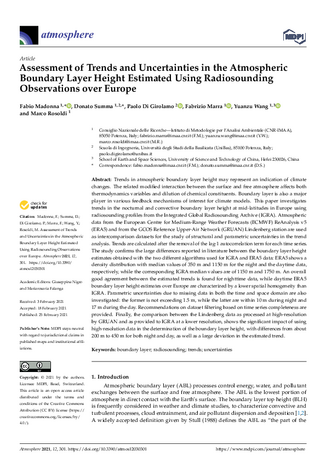Trends in atmospheric boundary layer height may represent an indication of climate changes. The related modified interaction between the surface and free atmosphere affects both thermodynamics variables and dilution of chemical constituents. Boundary layer is also a major player in various feedback mechanisms of interest for climate models. This paper investigates trends in the nocturnal and convective boundary layer height at mid-latitudes in Europe using radiosounding profiles from the Integrated Global Radiosounding Archive (IGRA). Atmospheric data from the European Centre for Medium-Range Weather Forecasts (ECMWF) ReAnalysis v5 (ERA5) and from the GCOS Reference Upper-Air Network (GRUAN) Lindenberg station are used as intercomparison datasets for the study of structural and parametric uncertainties in the trend analysis. Trends are calculated after the removal of the lag-1 autocorrelation term for each time series. The study confirms the large differences reported in literature between the boundary layer height estimates obtained with the two different algorithms used for IGRA and ERA5 data: ERA5 shows a density distribution with median values of 350 m and 1150 m for the night and the daytime data, respectively, while the corresponding IGRA median values are of 1150 m and 1750 m. An overall good agreement between the estimated trends is found for nighttime data, while daytime ERA5 boundary layer height estimates over Europe are characterized by a lower spatial homogeneity than IGRA. Parametric uncertainties due to missing data in both the time and space domain are also investigated: the former is not exceeding 1.5 m, while the latter are within 10 m during night and 17 m during the day. Recommendations on dataset filtering based on time series completeness are provided. Finally, the comparison between the Lindenberg data as processed at high-resolution by GRUAN and as provided to IGRA at a lower resolution, shows the significant impact of using high-resolution data in the determination of the boundary layer height, with differences from about 200 m to 450 m for both night and day, as well as a large deviation in the estimated trend.

GCOS Reference Upper-Air Network
Title
Assessment of Trends and Uncertainties in the Atmospheric Boundary Layer Height Estimated Using Radiosounding Observations over Europe
Authors
Madonna, F.; Summa, D.; Di Girolamo, P.; Marra, F.; Wang, Y.; Rosoldi, M.
Published
by Atmosphere (Atmos) at 2021-02-25
Abstract
